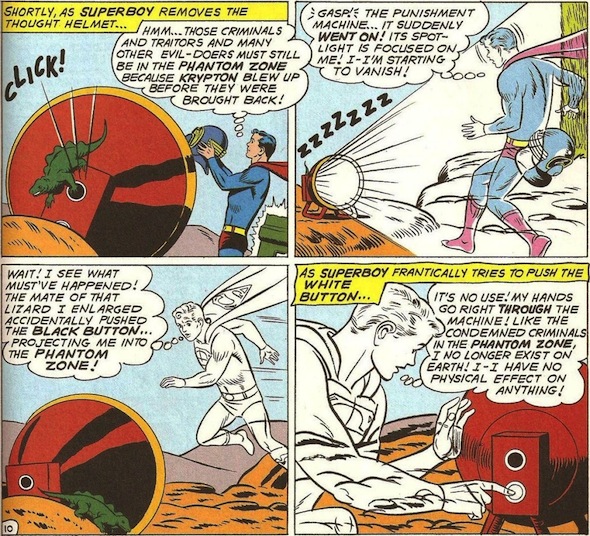An Ontology of Everything on the Face of the Earth
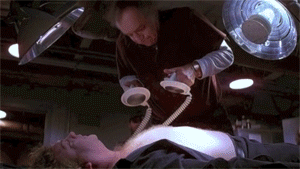
This essay was originally published as part of a special issue of Alluvium Journal on Digital Metaphors, edited by Zara Dinnen and featuring contributions from Rob Gallagher and Sophie Jones. John Carpenter’s 1982 film, The Thing, is a claustrophobic sci-fi thriller, exhibiting many hallmarks of the horror genre. The film depicts a sinister turn for matter, […]
Glitchometry

I wrote an essay for the publication accompanying Daniel Temkin‘s solo exhibition, GLITCHOMETRY, held at Transfer Gallery, New York – November 16 through December 14, 2013. The publication also features an interview with the artist by Curt Cloninger. Excerpt from my essay : Glitchometry turns away from the ‘new earth’; the milieu of cyphers that constitute our […]
What makes out today’s notworking is the social glitch
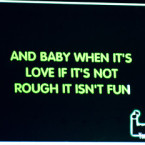
For 3 years I have collaborated on a project with Kyoung Kim. Known as GLTI.CH Karaoke, or sometimes just GLTI.CH, we’ve plotted the course of accidents, of temporal lyrical disjoints and technical out-of-syncs through a wide variety of different mediums, spaces and social conditions. This week saw what feels like the climax of our experiments, […]
This Mess is a Place


This Mess is a Place: A Collapsible Anthology of Collections and Clutter is a limited edition publication, edited/curated by Zoë Mendelson and published by And Publishing. It includes articles, artworks, interviews and fiction. Alongside This Mess is a Place’s own collaborators from psychiatric and archival fields there are contributions of artistic projects from Jim Bay (UK); Michel Blazy (FR); Carrie M Becker (USA); Marjolijn Dijkman (NL); Nat Goodden (UK), Jefford Horrigan (UK); Dean Hughes (UK); Mierle Laderman Ukeles (USA); Robert Melee (USA); Zoë Mendelson (UK); Florence Peake (UK); Michael Samuels (UK); Kathryn Spence (USA); Tomoko Takahashi; Robin Waart (NL); Julian Walker (UK) and Laura White (UK).
The publication contains essays and documents by Dr. Colin Jones (Senior Lecturer/Researcher in Applied Health and Social Sciences, UK); Dr. Haidy Geismar (lecturer in digital anthropology and material culture, US/UK); Jeremy Gill (urban planner and theorist, AUS); Cecilie Gravesen (artist, curator and writer, UK/Den); Dr. Alberto Pertusa (consultant psychiatrist, UK); Daniel Rourke (artist and researcher, UK); Isobel Hunter (archivist and Head of Engagement at the National Archives, UK); Satwant Singh (nurse practitioner and cognitive behavourial therapist, UK); Nina Folkersma (curator and critic, NL); Alberto Duman (artist, writer, UK). A full list of essay titles can be seen here. The publication also includes documentary photography by Paula Salischiker (ARG) and an interview with an anonymous hoarder’s daughter.
The publication will include a newly designed reprint of Italo Calvino’s essay of 1974-76, La Poubelle Agréée.
This publication looks at the onset of hoarding through the voices of clinicians and expands the theme to examine how relationships to objects in space inform a number of fields in ways that can be seen to interrelate and impact upon each other. The idea behind the form of this anthology is that practice and artistic research can co-exist with more clinical and scientific research. It is hoped this will create overlaps and crises of ‘usefulness’ akin to the submersion of materials within a hoard or the pursuit of order within a collection. The publication itself is unbound – illogical and precarious as an object, containing loose leaves, pamphlets and nominal filing systems, gathered together in no particular order. The reader is ultimately responsible for the order (or dis-order) of the piece. Publication date is October 26th 2013.
To order a copy after 27/10/13 please use the Paypal button on this page.
To stock copies in your bookstore or to order for libraries – please contact zoe@thismessisaplace.co.uk for special prices.


Conference Paper: How GIFs “Language” and What They Might Mean
International Conference on the Image, ‘How GIFs “Language” and What They Might Mean’, University Center Chicago, October 18th-19th 2013
Artist Profile: Erica Scourti
.gif)
The latest in a series of interviews with artists who have developed a significant body of work engaged (in its process, or in the issues it raises) with technology. See the full list of Artist Profiles here.
Daniel Rourke: Your recent work, You Could’ve Said, is described as “a Google keyword confessional for radio.” I’ve often considered your work as having elements of the confession, partly because of the deeply personal stance you perform—addressing we, the viewer or listener, in a one-on-one confluence, but also through the way your work hijacks and exposes the unseen, often algorithmic, functions of social and network media. You allow Google keywords to parasitize your identity and in turn you apparently “confess” on Google’s behalf. Are you in search of redemption for your social-media self? Or is it the soul of the algorithm you wish to save?
Erica Scourti: Or maybe the algorithm and social media soul is now so intertwined and interdependent that it makes little sense to even separate the two, in a unlikely fulfillment of Donna Haraway’s cyborg? Instead of having machines built into/onto us (Google glasses notwithstanding), the algorithms which parse our email content, Facebook behaviours, Amazon spending habits, and so on, don’t just read us, but shape us.
I’m interested in where agency resides when our desires, intentions and behaviours are constantly being tracked and manipulated through the media and technology that we inhabit; how can we claim to have any “authentic” desires? Facebook’s “About” section actually states, “You can’t be on Facebook without being your authentic self,” and yet this is a self that must fit into the predetermined format and is mostly defined by its commercial choices (clothing brands, movies, ice cream, whatever). And those choices are increasingly influenced by the algorithms through the ambient, personalized advertising that surrounds us.
So in You Could’ve Said, which is written entirely in an instrumentalised form of language, i.e. Google’s AdWords tool, I’m relaying the impossibility of having an authentic feeling, or even a first-hand experience, despite the seemingly subjective, emotional content and tone. Google search stuff is often seen reflective of a kind of cute “collective self” (hey, we all want to kill our boyfriends sometimes!) but perhaps it’s producing as much as reflecting us. It’s not just that everything’s already been said, and can be commodified but that the devices we share so much intimate time with are actively involved in shaping what we consider to be our “selves,” our identities.
And yet, despite being entirely mediated, my delivery is “sincere” and heartfelt; I’m really interested in the idea of sincere, but not authentic. I think it’s the same reason spambots can have such unexpected pathos; they seem to “express” things in a sincere way, which suggests some kind of “soul” at work there, or some kind of agency, and yet they totally lack interiority, or authenticity. In this and other work of mine (especially Life in AdWords) dissonance is produced by my apparent misrecognition of the algorithmically produced language as my own- mistaking the machine lingo as a true expression of my own subjectivity. Which is not to say that there is some separate, unmediated self that we could access if only we would disconnect our damn gadgets for a second, but the opposite—that autobiography, which my work clearly references, can no longer be seen as a narrative produced by some sort of autonomous subject, inseparable from the technology it interacts with.
Also, autobiography often involves a confessional, affective mode, and I’m interested in how this relates to the self-exposure which the attention economy seems to encourage—TMI can secure visibility when there’s not enough attention to go round. With the Google confessional, I’m enacting an exposure of my flaws and vulnerabilities and while it’s potentially “bad” for me (i.e. my mediated self) since you might think I’m a loser, if you’re watching, then it’s worth it, since value is produced simply through attention-retention. Affective vitality doesn’t so much resist commodification as actively participate within it…
DR: You mention agency. When it comes to the algorithms that drive the current attention economy I tend to think we have very little. Active participation is all well and good, but the opposite—an opting out, rather than a passivity—feels increasingly impossible. I am thinking about those reCaptcha questions we spend all our time filling in. If I want to access my account and check the recommendations it has this week, I’m required to take part in this omnipresent, undeniably clever, piece of crowd-sourcing. Alan Turing’s predictions of a world filled with apparently intelligent machines has come true, except, its the machines now deciding whether we are human or not.
ES: Except of course—stating the obvious here—it’s just carrying out the orders another human instructed it to, a mediated form of gatekeeping that delegates responsibility to the machine, creating a distance from the entirely human, social, political etc structure that has deemed it necessary (a bit like drones then?).
I’m very interested also in the notion of participation as compulsory—what Zizek calls the “You must, because you can” moral imperative of consumerism—especially online, not just at the banal level (missing out on events, job opportunities, interesting articles and so on if you’re not on Facebook) but because your actions necessarily feed back into the algorithms tracking and parsing our behaviours. And even opting out becomes a choice that positions you within a particular demographic (more likely to be vegetarian, apparently).
Also, this question of opting out seems to recur in conversations around art made online, in a way it doesn’t for artists working with traditional media—like, if you’re being critical of it, why not go make your own Facebook, why not opt out? My reasoning is that I like to work with widely used technology, out of an idea that the proximity of these media to mainstream, domestic and wider social contexts makes the work more able to reflect on its sociopolitical implications, just as some video artists working in the 80s specifically engaged with TV as the main mediator of public consciousness. Of course some say this is interpassiviity, just feebly participating in the platforms without making any real change, and I can understand that criticism. Now that coded spaces and ubiquitous computing are a reality of the world—and power structures—we inhabit, I do appreciate artists who can work with code and software (in a way that I can’t) and use their deeper understanding of digital infrastructure to reflect critically on it.
DR: You’ve been engaged in a commision for Colm Cille’s Spiral, sending personal video postcards to anyone who makes a request. Your interpretation of the “confessional” mode seems in this piece to become very human-centric again, since the work is addressed specifically at one particular individual. How has this work been disseminated, and what does your approach have to do with “intimacy”?
ES: I’ve always liked Walter Benjamin’s take on the ability of mediating technologies to traverse spatial distances, bringing previously inaccessible events within touching distance. With this project, I wanted to heighten this disembodied intimacy by sending unedited videos shot on my iPhone, a device that’s physically on me at all times, directly to the recipients’ inbox. So it’s not just “sharing” but actually “giving” them a unique video file gift, which only they see, positioning the recipient as a captive audience of one, unlike on social media where you have no idea who is watching or who cares. But also, I asked them to “complete” the video by adding its metadata, which puts them on the spot—they have to respond, instead of having the option to ignore me—and also extracting some labor in return, which is exactly what social media does: extracting our affective and attentive labor, supposedly optionally, in exchange for the gift of the free service.
The metadata—tags, title and optionally a caption—became the only viewable part of the exchange, since I used it to annotate a corresponding black, “empty” video on Instagram, also shared on Twitter and Facebook, so the original content remains private. These blank videos record the creative output of the recipient, while acting as proof of the transaction (i.e. that I sent them a video). They also act as performative objects which will continue to operate online due to their tagging, which connects them to other groups of media and renders them visible—i.e. searchable—online, since search bots cannot as yet “see” video content. I wanted to make a work which foregrounds its own connectedness, both to other images via the hashtags but also to the author-recipients through tagging them on social media. So the process of constantly producing and updating oneself within the restrictive and pre-determined formats of social media platforms, i.e. their desired user behaviours, becomes almost the content of the piece.
I also like the idea that hashtag searches on all these platforms, for (let’s say) Greece, will bring up these blank/ black videos (which by the way, involved a little hack, as Instagram will not allow you to upload pre-recorded content and it’s impossible to record a black and silent video…). It’s a tiny intervention into the regime of carefully filtered and cropped life-style depictions that Instagram is best known for.
It’s also a gesture of submitting oneself to the panoptical imperative to share one’s experience no matter how private or banal, hence using Instagram for its associations with a certain solipsistic self-display; by willingly enacting the production of mediated self on social media I’m exploring a kind of masochistic humour which has some affinities with what Benjamin Noys identified as an accelerationist attitude of “the worse the better.” And yet, by remaining hidden, and not publicly viewable, the public performance of a mediated self is denied.
.jpg)
DR: An accelerationist Social Media artwork would have to be loaded with sincerity, firstly, on the part of the human (artist/performer), but also, in an authentic attempt to utilise the network completely on its terms. Is there something, then, about abundance and saturation in your work? An attempt to overload the panopticon?
ES: That’s a very interesting way of putting it. I sometimes relate that oversaturation to the horror vacui of art that springs from a self-therapeutic need, which my work addresses, though it’s less obsessive scribbles, more endless connection, output and flow and semi-ritualistic and repetitive working processes. And in terms of utilizing the network on its own terms, Geert Lovink’s notion of the “natural language hack” (rather than the “deep level” hack) is one I’ve thought about—where your understanding of the social, rather than technical, operation of online platforms gets your work disseminated. For example my project Woman Nature Alone, where I re-enacted stock video which is freely available on my Youtube channel—some of those videos are high on the Google ranking page, so Google is effectively “marketing” my work without me doing anything.
Whether it overloads the panopticon, or just contributes more to the babble, is a pertinent question (as Jodi Dean’s work around communicative capitalism has shown), since if the work is disseminated on commercial platforms like YouTube or Facebook, it operates within a system of value generation which benefits the corporation, involving, as is by now well known, a Faustian pact of personal data in exchange for “free” service.
And going back to agency—the mutability of the platforms means that if the work makes use of particular features (suchas YouTube annotations) its existence is contingent on them being continued; since the content and the context are inextricable in situations like this, it would become impossible to display the original work exactly as it was first made and seen. Even then, as with Olia Lialina and Dragan Espenschied’s One Terabyte of Kilobyte Age, it would become an archive, which preserves documents from a specific point in the web’s history but cannot replicate the original viewing conditions because all the infrastructure around it has changed completely. So if the platforms—the corporations—control the context and viewing conditions, then artists working within them are arguably at their mercy- and keeping the endless flow alive by adding to it.
I’m more interested in working within the flows rather than, as some artists prefer, rejecting the dissemination of their work online. Particularly with moving image work, I’m torn between feeling that artists’ insistence on certain very specific, usually high quality, viewing conditions for their work bolsters, as Sven Lütticken has argued, the notion of the rarefied auratic art object whose appreciation requires a kind of hushed awe and reverence, while being aware that the opposite—the image ripped from its original location and circulated in crap-res iPhone pics/ videos—is an example of what David Joselit would call image neoliberalism, which sees images as site-less and like any other commodity, to be traded across borders and contexts with no respect for the artist’s intentions.
However, I also think that this circulation is becoming an inevitability and no matter how much you insist your video is viewed on zillion lumens projector (or whatever), it will most likely end up being seen by the majority of viewers on YouTube or on a phone screen; I’m interested in how artists (like Hito Steyerl) address, rather than avoid, the fact of this image velocity and spread.
DR: Lastly, what have you been working on recently? What’s next?
ES: I recently did a series of live, improvised performance series called Other People’s Problems direct to people’s desktops, with Field Broadcast, where I read out streams of tags and captions off Tumblr, Instagram and Facebook, randomly jumping to other tags as I went. I’m fascinated by tags—they’re often highly idiosyncratic and personal, as well as acting as connective tissue between dispersed users; but also I liked the improvisation, where something can go wrong and the awkwardness it creates. (I love awkwardness!) Future projects are going to explore some of the ideas this work generated: how to improvise online (when things can always be deleted/ rejigged afterwards), how to embrace the relinquishing of authorial control which I see as integral to the online (or at least social media) experience, and how to work with hashtags/ metadata both as text in its own right and as a tool.

Age: 33
Location: London, Athens when I can manage it
How long have you been working creatively with technology? How did you start?
14, 15 maybe, when I started mucking around with Photoshop—I remember scanning a drawing I’d made of a skunk from a Disney tale and making it into a horrendous composition featuring a rasta flag background… I was young. And I’ve always been obsessed with documenting things; growing up I was usually the one in our gang who had the camera—showing my age here, imagine there being one person with a camera—which has given me plenty of blackmail leverage and a big box of tastefully weathered photos that, despite my general frustration with analogue nostalgia, I know I will be carrying around with me for life.
Where did you go to school? What did you study?
After doing Physics, Chemistry and Maths at school, I did one year of a Chemistry BA, until I realized I wasn’t cut out for lab work (too much like cooking) or what seemed like the black-and-white nature of scientific enquiry. I then did an art and design foundation at a fashion college, followed by one year of Fine Art Textiles BA—a nonsensical course whose only redeeming feature was its grounding in feminist theory—before finally entering the second year of a Fine Art BA. For a while this patchy trajectory through art school made me paranoid, until I realised it probably made me sound more interesting than I am. And in my attempt to alleviate the suspicion that there was some vital piece of information I was missing, I also did loads of philosophy diploma courses, which actually did come in handy when back at Uni last year: I recently finished a Masters of Research in moving image art.
What do you do for a living or what occupations have you held previously? Do you think this work relates to your art practice in a significant way?
At the moment I’m just about surviving as an artist and I’ve always been freelance apart from time done in bar, kitchen, shop (Londoners, remember Cyberdog?) cleaning and nightclub jobs, some of which the passage of time has rendered as amusingly risqué rather than borderline exploitative. After my B.A., I set up in business with the Prince’s Trust, running projects with what are euphemistically known as hard-to-reach young people, making videos, digital art pieces and music videos until government funding was pulled from the sector. I mostly loved this work and it definitely fed into and reflects my working with members of loose groups, like the meditation community around the Insight Time app, or Freecycle, or Facebook friends. I’ve also been assisting artist and writer Caroline Bergvall on and off for a few years, which has been very helpful in terms of observing how an artist makes a life/ living.
What does your desktop or workspace look like?
I’m just settling into a new space at the moment but invariably, a bit of a mess, a cup of tea, piles of books, and both desktop and workspace are are covered in neon post-it notes. Generally I am a paradigmatic post-Fordist flexi worker though: I can and do work pretty much anywhere—to the occasional frustration of friends and family.

The Phantom Zone

The boundary between science fiction and social reality is an optical illusion.
Donna Haraway, A Cyborg Manifesto (1991) [1]
This is no fantasy… no careless product of wild imagination. No, my good friends.
The opening lines of Richard Donner’s Superman (1978) [2]
In a 1950 film serial entitled Atom Man vs Superman [3] television executive and evil genius Lex Luthor sends Superman into a ghostly limbo he calls “The Empty Doom.” Trapped in this phantom void, Superman’s infinite powers are rendered useless, for although he can still see and hear the “real” world his ability to interact with it has all but disappeared. Over the following decades this paraspace [4]—to use Samuel Delany’s term for a fictional space, accessed via technology, that is neither within nor entirely separate from the ‘real’ world—would reappear in the Superman mythos in various forms, beginning in 1961. Eventually dubbed “The Phantom Zone,” its back story was reworked substantially, until by the mid 60s it had become a parallel dimension discovered by Superman’s father, Jor El. Once used to incarcerate Krypton’s most unsavory characters, The Phantom Zone had outlasted its doomed home world and eventually burst at the seams, sending legions of super-evil denizens raining down onto Earth. Beginning its life as an empty doom, The Phantom Zone was soon filled with terrors prolific enough to make even The Man of Steel fear its existence.
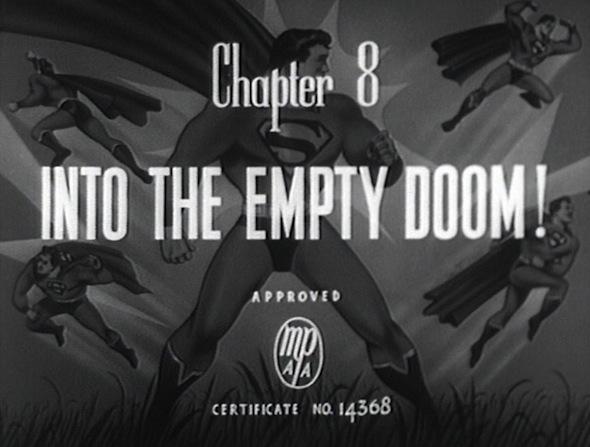

Overseen by story editor Mortimer Weisinger, and the unfortunately named artist Wayne Boring, the late 50s and early 60s were a strange time in the Superman universe. The comics suddenly became filled with mutated variants of kryptonite that gave Superman the head of an ant or the ability to read thoughts; with miniature Supermen arriving seconds before their namesake to save the day and steal his thunder; with vast universes of time caught fast in single comic book panels. It was an era of narrative excess wrapped by a tighter, more meticulous and, many would say, repressed aesthetic:
Centuries of epic time could pass in a single caption. Synasties fell between balloons, and the sun could grow old and die on the turn of a page. It was a toy world, too, observed through the wrong end of a telescope. Boring made eternity tiny, capable of being held in two small hands. He reduced the infinite to fit in a cameo… [5]
The Phantom Zone is one of the least bizarre narrative concepts from what is now known as the Silver Age of D.C. Comics (following on from the more widely celebrated Golden Age). It could be readily understood on a narrative level, and it had a metaphorical dimension as well, one that made conceivable the depths contained in Superman’s vast, but ultimately manipulable universe. The Phantom Zone was usually portrayed on a television screen kept safe in one of the many rooms of the League of Justice headquarters. It could also be used as a weapon and fired from a portable projection device—the cold, harsh infinity of the Empty Doom blazing into Superman’s world long enough to ensnare any character foolish enough to stand in its rays. Whether glimpsed on screen or via projection, then, The Phantom Zone could be interpreted as a metaphor for the moving image.

In comic books, as in the moving image, the frame is the constituent element of narrative. Each page of a comic book is a frame which itself frames a series of frames, so that by altering each panel’s size, bleed or aesthetic variety, time and space can be made elastic. Weisinger and Boring’s Phantom Zone took this mechanism further, behaving like a weaponized frame free to roam within the comic book world. Rather than manipulating three-dimensional space or the fourth dimension of time, as the comic book frame does, The Phantom Zone opened out onto the existence of other dimensions. It was a comic book device that bled beyond the edge of the page, out into a world in which comic book narratives were experienced not in isolation, but in parallel with the onscreen narratives of the cinema and the television. As such, the device heralded televisual modes of attention.
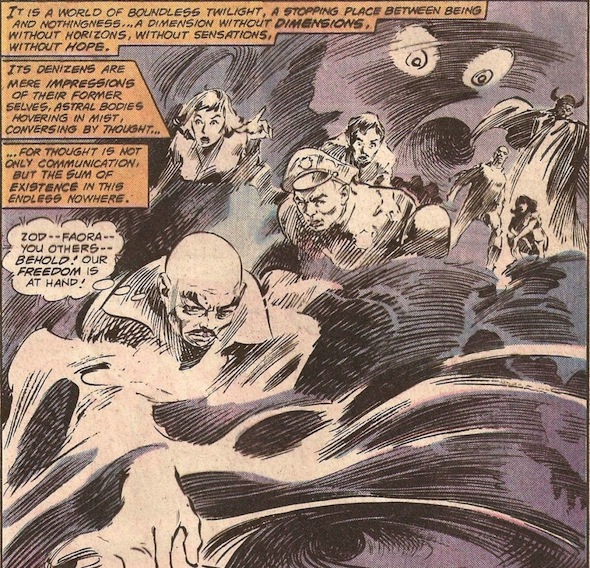
For his 1978 big-budget movie version of Superman, [6] director Richard Donner cunningly translated The Phantom Zone into something resembling the cinema screen itself. In the film’s opening sequence, a crystal surface swoops down from the immense backdrop of space, rendering the despicable General Zod and his cronies two-dimensional as it imprisons them. In the documentary The Magic Behind the Cape, [7] bundled with the DVD release of Superman in 2001, we are given an insight into the technical prowess behind Donner’s The Phantom Zone. The actors are made to simulate existential terror against the black void of the studio, pressed up against translucent, flesh-like membranes and physically rotated out of sync with the gaze of the camera. Rendering the faux two-dimensional surface of Donner’s Phantom Zone believable required all manner of human dimensions to be framed out of the final production. The actors react to causes generated beyond the studio space, the director’s commands, or the camera’s gaze. They twist and recoil from transformations still to occur in post-production. In a sense, the actors behave as bodies that are already images. With its reliance on post-produced visual effects, the Phantom Zone sequence represents an intermediary stage in the gradual removal of sets, locations, and any ‘actual’ spatial depths from the film production process. Today, actors must address their humanity to green voids post-produced with CGI, and the indexical relationship between the film image and the events unfolding in front of the lens have been almost entirely shattered. In this Phantom cinema produced after the event, ever-deeper layers of special effects seal actors into a cinematic paraspace. Just as The Phantom Zone of the comic book heralded televisual modes of attention, The Phantom Zone of the 1970s marked a perceptual regime in which the cinematic image was increasingly sealed off from reality by synthetic visual effects.

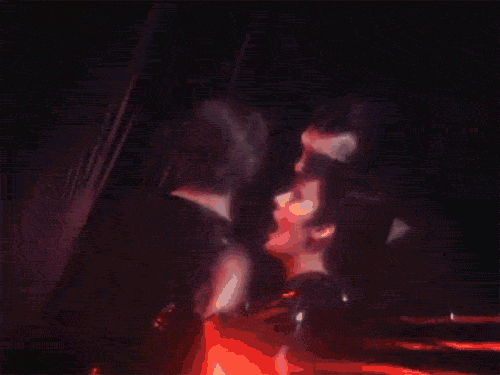

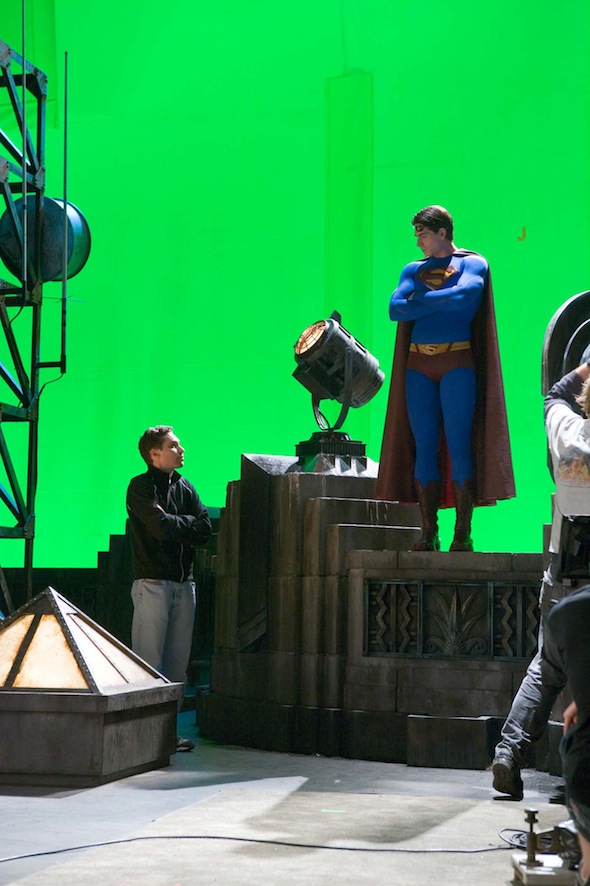
For Walter Benjamin, writing during cinema’s first “Golden Era,”, the ability of the cinema screen to frame discontinuous times and spaces represented its most profound “truth.” Delivered by cinema, Benjamin argued, mechanically disseminated images were actually fracturing the limits of our perceptions, training “human beings in the apperceptions and reactions needed to deal with a vast apparatus whose role in their lives is expanding almost daily.” [8] The cinema screen offered audiences who were confined to finite bodies that had never before experienced such juxtapositions an apparently shared experience of illuminated consciousness. Far from inventing this new mode of perception through the “shock-character” of montage, Benjamin believed that cinema spoke of the ‘truths’ which awaited us beneath the mirage of proletarian experience. Truths which would guide us—with utopian fervor—towards an awareness, and eventual control, of what Benjamin called the “new nature”:
Not just industrial technology, but the entire world of matter (including human beings) as it has been transformed by that technology. [9]
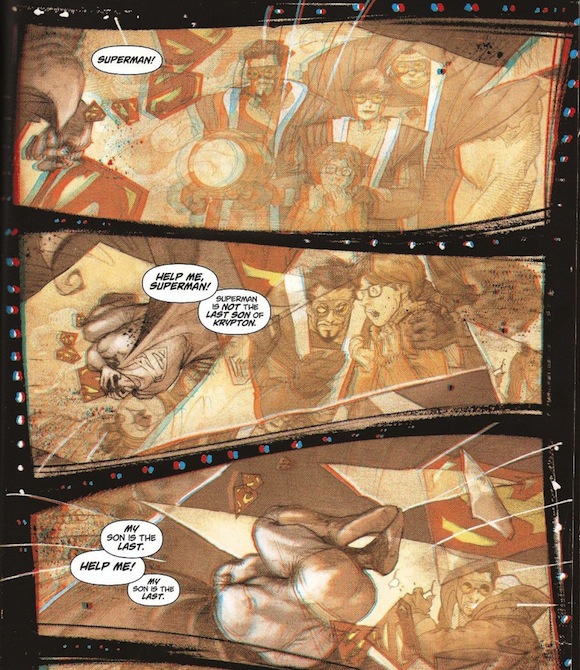
In short, cinema was less a technology than a new and evolving mode of machinic thought, both generated by and generating the post-industrial subject. Observing the relation between representation and visibility, Jens Andermann notes:
Truth, the truth of representation, crucially depends on the clear-cut separation between the visible and the invisible, the non-objectness of the latter. Truth is the effect of what we could call the catachretic nature of visuality, the way in which the world of visual objects can point to the invisible domain of pure being only by obsessively pointing to itself. [10]
As from the Greek root aisthanesthai – “to perceive”—the aesthetic conditions through which The Phantom Zone have been translated frame far more than a supposed fictional void. Called upon to indicate an absolute outside — the unfathomable infinity of another, ghostly, parallel universe — The Phantom Zone instead reiterates the medium of its delivery, whether comic book, television, or cinema, with mirror-like insistency. Such is the power of new technical modes of thought, that very often, they cause us to rethink the outmoded media that we are so used to as to be unaware.
The Phantom Zone hides the cinematographic image in plain view. Its reappearance and reimagining over the last 60 odd years, in ever newer forms and aesthetic modes, can be read paradigmatically, that is, as a figure that stands in place of, and points towards, shifts, mutations and absolute overturnings in our perceptual apparatus. Its most recent iteration is in the 2013 Superman reboot, Man of Steel, [11] and in particular in a ‘viral’ trailer distributed on YouTube a few weeks before the film was released. [12] Coming towards us soars a new mode of machinic thought; a Phantom Zone of unparalleled depth and aesthetic complexity that opens onto a new new – digital – nature.
The General Zod trailer for Man of Steel begins with a static rift that breaks into a visual and audial disarrangement of the phrase, “You are not alone”. General Zod’s masked face materializes, blended with the digital miasma: a painterly 3D effect that highlights the inherent ‘otherness’ of where his message originates. The aesthetic is unsettling in as much as it is recognizable. We have no doubt as viewers of this ‘viral’ dispatch as to the narrative meaning of what we are witnessing, namely, a datastream compressed and distributed from a paraspace by an entity very much unlike us. The uncanny significance of the trailer stems more from how very normal the digital miasma feels; from how apprehensible this barrage of noise is to us. Indeed, it is ‘other’, but its otherness is also somehow routine, foreseeable. The pathogen here is not Zod’s message, it is digital technology itself. The glitched aesthetic of the trailer has become so habitual as to herald the passing of digital materiality into the background of awareness. Its mode of dissemination, via the Trojan Horse of YouTube, just as unvisible to us during the regular shifts we make between online/offline modes of communication. The surface of this Phantom Zone very much interfaces with our material world, even if the message it impresses upon us aches to be composed of an alien substance.
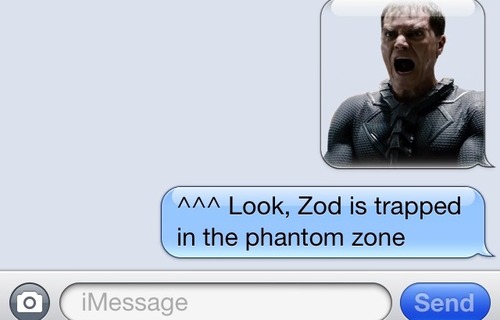
Digital video does the work of representation via a series of very clever algorithms called codecs that compress the amount of information needed to produce a moving image. Rather than the individual frames of film, each as visually rich and total as the last, in a codec only the difference between frames need be encoded, making each frame “more like a set of movement instructions than an image.” [13] The painterly technique used in the General Zod trailer is normally derived from a collapse between key (image) and reference (difference) frames at the status of encoding. The process is called ‘datamoshing‘, and has its origins in glitch art, a form of media manipulation predicated on those minute moments when the surface of an image or sound cracks open to reveal some aspect of the process that produced it. By a method of cutting, repeating or glitching of key and reference frames visual representations are made to blend into one another, space becomes difference and time becomes image. The General Zod trailer homages/copies/steals the datamoshing technique, marking digital video’s final move from convenient means of dissemination, to palpable aesthetic and cultural influence.
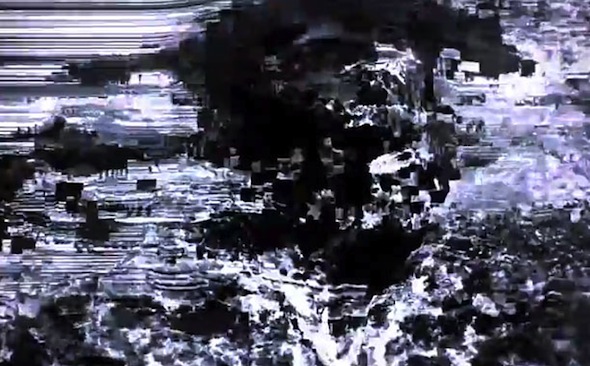
In the actual movie, Man of Steel (2013), Zod’s video message is transposed in its entirety to the fictional Planet Earth. The viral component of its movement around the web is entirely absent: its apparent digitality, therefore, remains somewhat intact, but only as a mere surface appearance. This time around the message shattering through The Phantom Zone is completely devoid of affective power: it frames nothing but its existence as a narrative device. The filmmakers rely on a series of “taking over the world” tropes to set the stage for General Zod’s Earth-shaking proclamation. TV sets in stereotypical, exotic, locales flicker into life, all broadcasting the same thing. Electronic billboards light up, loudspeakers blare, mobile phones rumble in pockets, indeed, all imaging technologies suddenly take on the role of prostheses for a single, datamoshed, stream. In one—particularly sincere—moment of the montage a faceless character clutches a Nokia brand smartphone in the centre of shot and exclaims, “It’s coming through the RSS feeds!” This surface, this Phantom Zone, frames an apparatus far vaster than a datamoshed image codec: an apparatus apparently impossible to represent through the medium of cinema. The surface appearance of the original viral trailer is only a small component of what constitutes the image it conveys, and thus, of the image it frames of our time. Digital materiality shows itself via poorly compressed video clips arriving through streams of overburdened bandwidth. Our understanding of what constitutes a digital image must then, according to Mark Hansen, “be extended to encompass the entire process by which information is made perceivable.” [14]
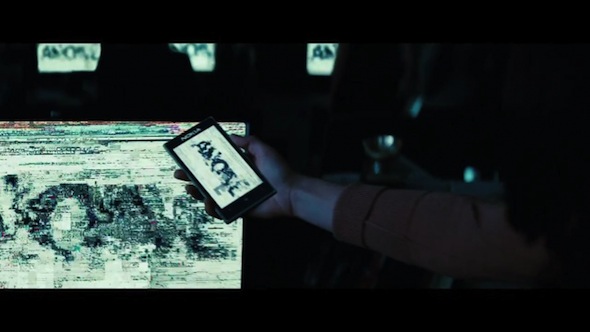
In its cinematic and comic book guises, The Phantom Zone was depicted as “a kind of membrane dividing yet connecting two worlds that are alien to and also dependent upon each other”.[15] The success of the datamoshed trailer comes from the way it broke through that interface, its visual surface bubbling with a new kind of viral, digital, potential that encompasses and exposes the material engaged in its delivery. As cinematographic subjects we have an integral understanding of the materiality of film. Although we know that the frames of cinema are separate we crave the illusion of movement, and the image of time, they create. The ‘viral’ datamoshed message corrupts this separation between image and movement, the viewer and the viewed. Not only does General Zod seem to push out, from inside the numerical image, it is as if we, the viewing subject enraptured by the digital event, have been consumed by its flow. The datamoshed Phantom Zone trailer takes the one last, brave, step beyond the apparatus of image production. Not only is the studio, the actor, and even the slick appeal of CGI framed out of its mode of delivery, arriving through a network that holds us complicit, this Phantom Zone frames the ‘real’ world in its entirety, making even the fictional world it appeals to devoid of affective impact. To take liberty with the words of Jean Baudrillard:
[Jorge Luis] Borges wrote: they are slaves to resemblance and representation; a day will come when they will try to stop resembling. They will go to the other side of the mirror and destroy the empire. But here, you cannot come back from the other side. The empire is on both sides. [16]
Once again, The Phantom Zone highlights the material mode of its delivery with uncanny exactness. We are now surrounded by images that supersede mere visual appearance: they generate and are generated by everything the digital touches, including we, the most important component of General Zod’s ‘viral’ diffusion. The digital Phantom Zone extends to both sides of the flickering screen.
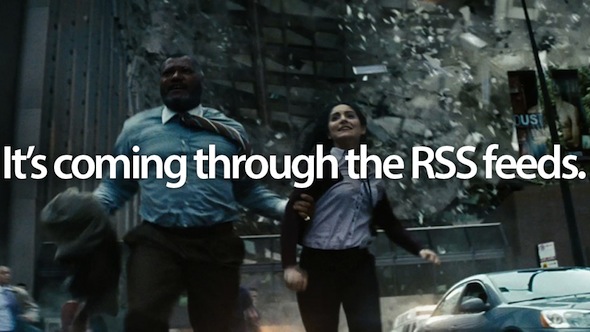
References
[1] Donna Haraway, Simians, Cyborgs and Women : The Reinvention of Nature. (London: Free Association Books Ltd, 1991), 149–181.
[2] Richard Donner, Superman, Action, Adventure, Sci-Fi, 1978.
[3] Spencer Gordon Bennet, Atom Man Vs. Superman, Sci-Fi, 1950.
[4] Scott Bukatman, Terminal Identity: The Virtual Subject in Postmodern Science Fiction (Durham: Duke University Press, 1993), 164.
[5] Grant Morrison, Supergods: Our World in the Age of the Superhero (London: Vintage Books, 2012), 62.
[6] Donner, Superman.
[7] Michael Thau, The Magic Behind the Cape, Documentary, Short, 2001. See : http://www.youtube.com/watch?v=bYXbzVJ6NzA&feature=youtu.be&t=4m12s
[8] Walter Benjamin, “The Work of Art in the Age of Its Technological Reproducibility,” in The Work of Art in the Age of Its Technological Reproducibility, and Other Writings on Media (Cambridge Mass.: Belknap Press of Harvard University Press, 2008), 26.
[9] Susan Buck-Morss, The Dialectics of Seeing: Walter Benjamin and the Arcades Project (MIT Press, 1991), 70.
[10] Jens Andermann, The Optic of the State: Visuality and Power in Argentina and Brazil (University of Pittsburgh Pre, 2007), 5.
[11] Zack Snyder, Man of Steel, Action, Adventure, Fantasy, Sci-Fi, 2013.
[12] Man of Steel Viral – General Zod’s Warning (2013) Superman Movie HD, 2013, http://www.youtube.com/watch?v=5QkfmqsDTgY.
[13] BackStarCreativeMedia, “Datamoshing—the Beauty of Glitch,” April 9, 2009, http://backstar.com/blog/2009/04/09/datamoshing-the-beauty-of-glitch/.
[14] Mark B. Hansen, “Cinema Beyond Cybernetics, or How to Frame the Digital Image,” Configurations 10, no. 1 (2002): 54, doi:10.1353/con.2003.0005.
[15] Mark Poster, The Second Media Age (Wiley, 1995), 20.
[16] Jean Baudrillard, “The Murder of the Sign,” in Consumption in an Age of Information, ed. Sande Cohen and R. L. Rutsky (Berg, 2005), 11.
